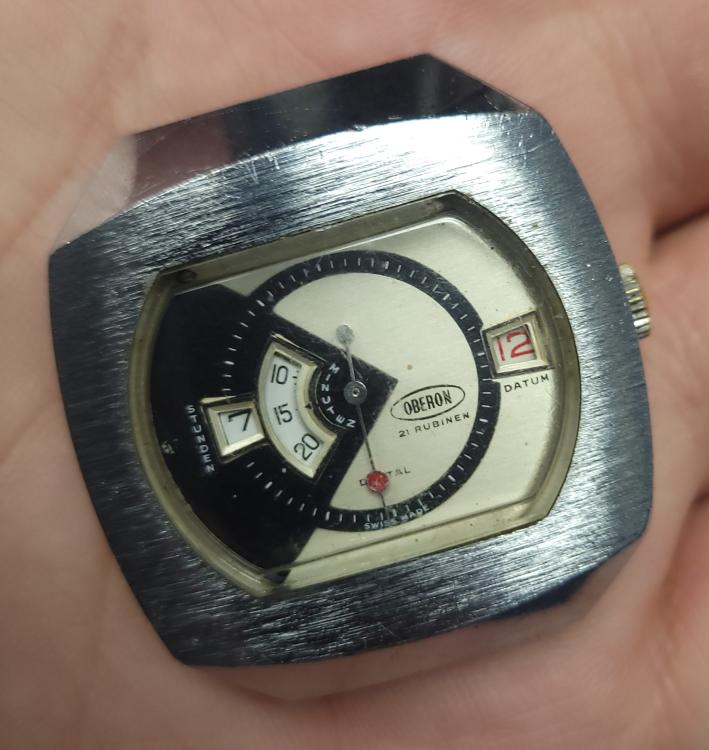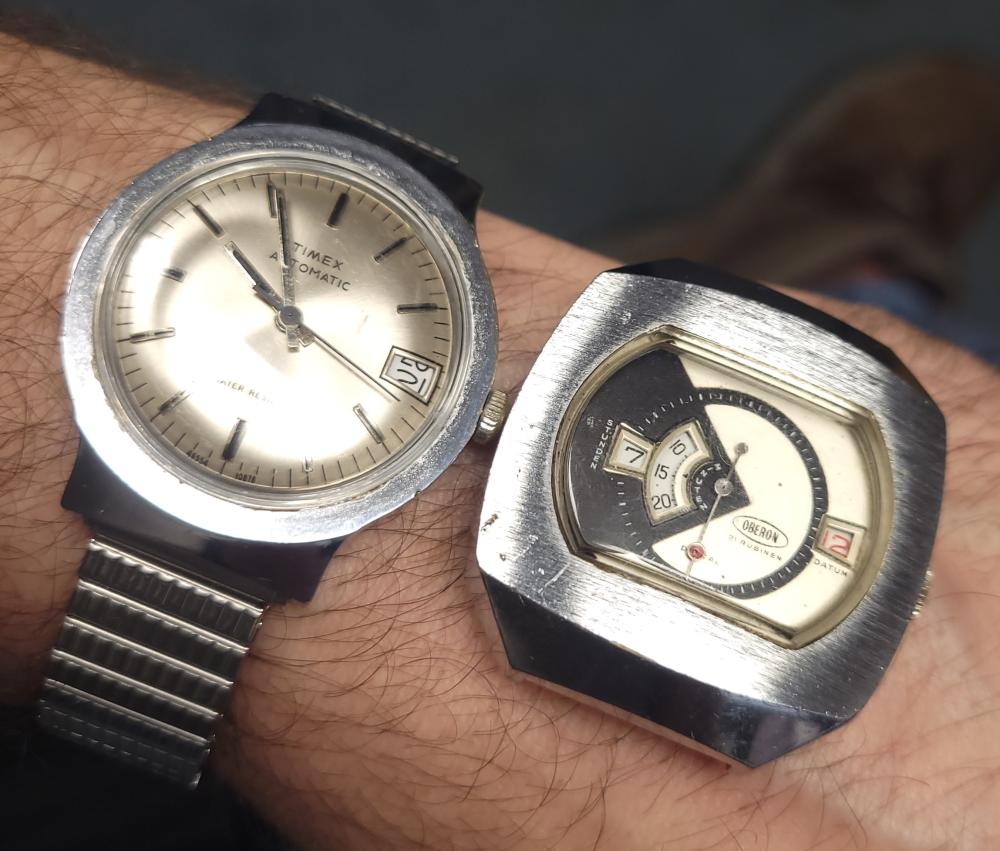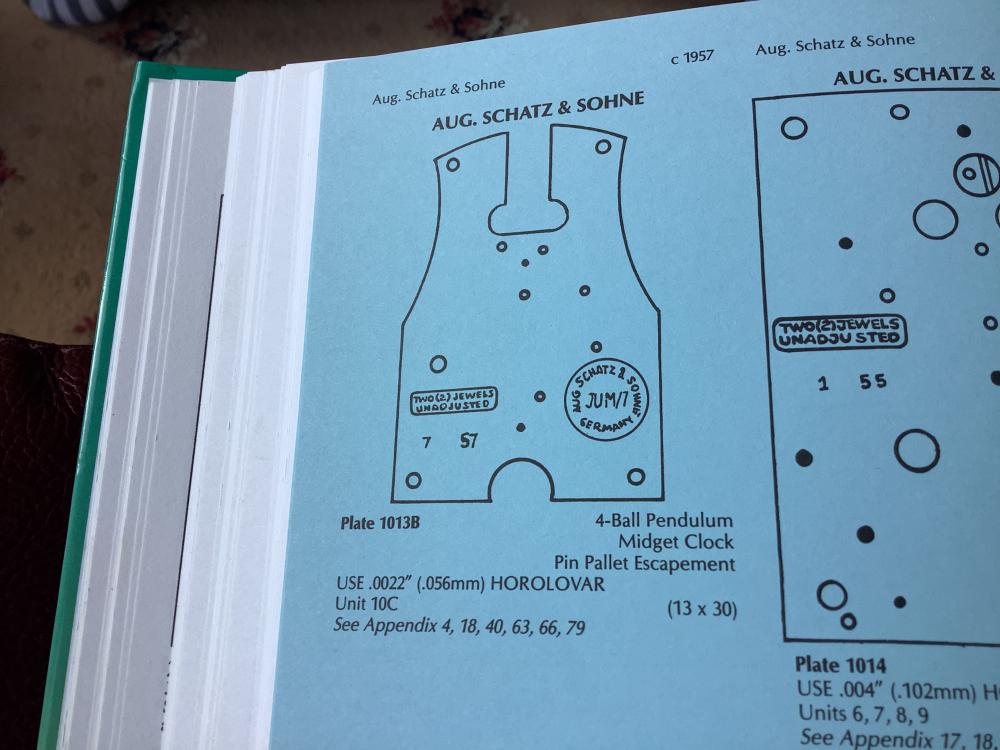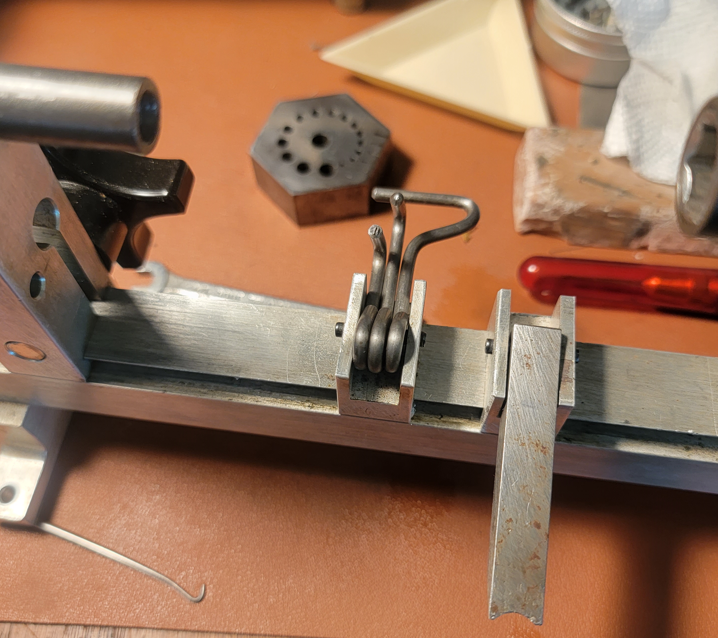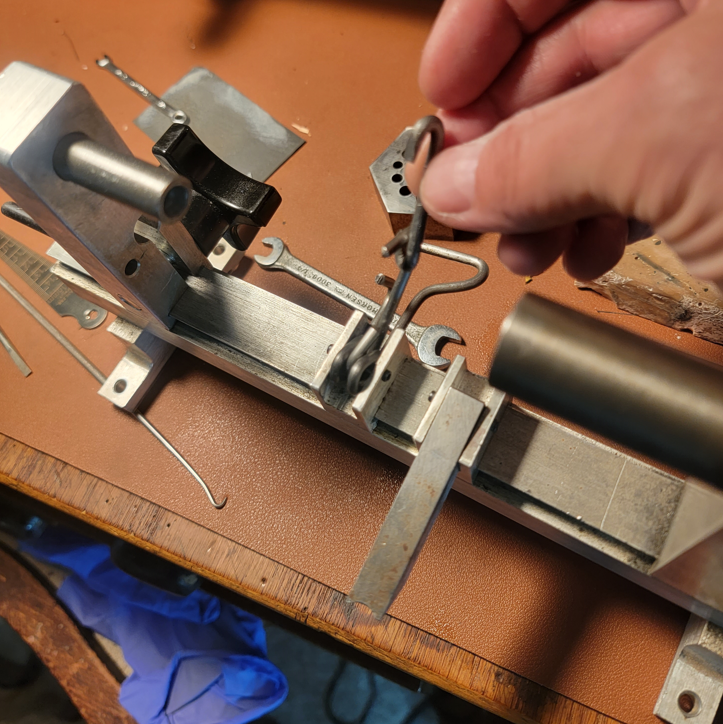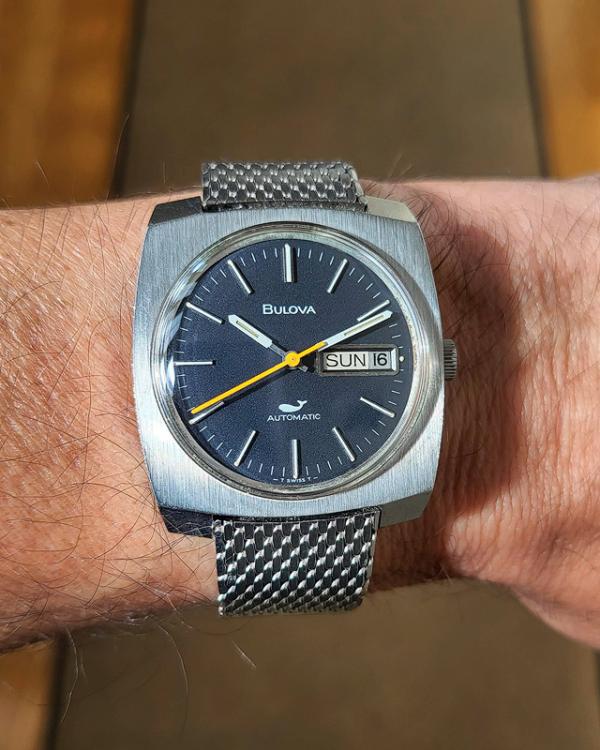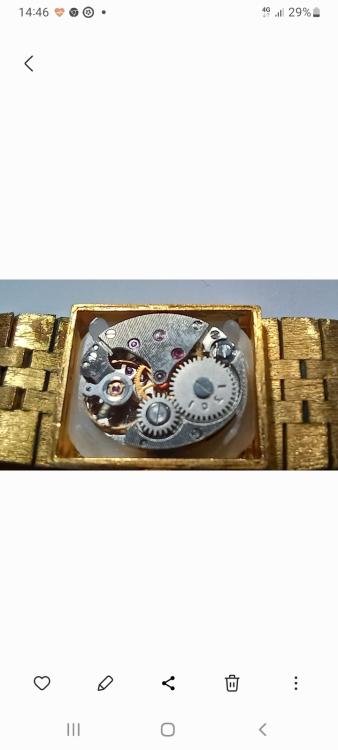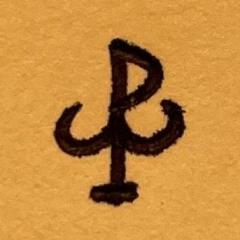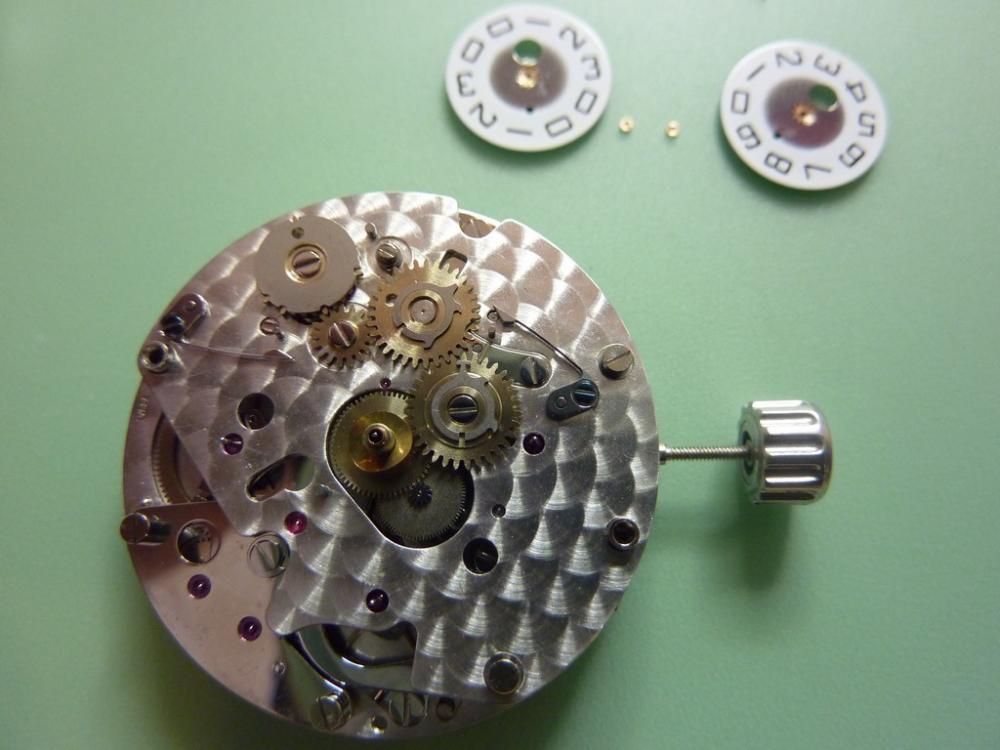Leaderboard
Popular Content
Showing content with the highest reputation on 04/18/23 in all areas
-
How about breaking the scrap bridge to release the pin, grab the bridge in plier to bend/break the bridge near the pin, usually comes loose if you just bent the bridge. Insert the pin from the end that you say you messed to have the good half sticking out. Good luck3 points
-
That worked perfectly - just needed a slight bend of the bridge to free the pin. Then pushed in, damaged end first. Thanks @Nucejoe2 points
-
Try heat, both the pin and plate will expand but it may work.2 points
-
Esslinger sells GS crystals. What I find is that I end up buying several crystals and use the one that fits. When the opportunity arises, I buy crystal lots. Seems inefficient, but I have probably fitted a dozen crystals from those lots. You figure $20 for a crystal (not unusual given the tax and shipping), that is $240. Probably what I have invested more or less. For pocket watches, I have a zillion crystals that I essentially got for free.2 points
-
2 points
-
Lubricants (oils) are made from standard base-stocks of given viscosity. This applies to both natural mineral oils and synthetic (POA) oils, (not chemicals) These base stocks are then blended to get to the required viscosity. Normally a thinner oil is added to a thicker oil to get a lower viscosity than the thicker oil. All oils have a range of molecules and the lesser/greater sizes are referred to as light ends or heavy ends. To 'evaporate' an oil would require temps well in excess of normal temps (even tropical areas). However some evaporation can occur with the very light ends and the heavy ends will tend to oxidise more, particularly at higher ambient temps. Both these effects will tend to thicken the oil. The more blended an oil the greater the effect would be, but still miniscule in the realm of things. This is why the sticky residues are found in bearings etc in old watches and non-serviced watches. Synthetic oils (PAO and not 'chemicals') have much better control of the molecule size and therefore have much fewer light and heavy ends. They therefore tend to degrade less noticeably (ie oil thickening). Some oils (both types) have 'addtives' incorporated to control other factors (extreme pressure EP, ant-iwear, metal pacification etc). These additives will do their job whether the oil is active or not and some will be 'consumed' doing that job, so a further age related degradation occurs. If the oil has stayed in place, then it will probably still lubricate ok. If it has spread, then the part it should be lubricating will be starved of oil and will therefore wear more rapidly. Obviously the comments above re servicing make sense if the watch is to be worn regularly again2 points
-
what I find interesting with this is the local material house she would actually prefer to fit the crystal for you versus giving you the crystal. as because she found there's variations in the crystal size versus the package. So if you would get her really close to what you need she could then pull it out and fitted for you and then you'd know that it actually fits. I can't remember the conversation exactly but I think it's basically a lot of the dies for making the crystals are getting old there may be some variation perhaps. these particular crystal lots you want to narrow down what you're looking at? The reason I ask is local a someone who bought out of material house gave a lecture on crystals and was explaining how at one time the mad crystal the month club. Some firm would sell you X quantity crystals per month so you can build up a big assortment. But the problem is and even with GS crystals of you look at how many crystals in the catalog and start to figure out how many crystals you're going to use you can end up the same as this person did with literally thousands of crystals that you're probably never ever going to use. This sort of thing shows up at the nawcc regional meetings were someone will have a crystal Is a lot of money for it. on the grounds that each crystals worth this much money the cabinet must be worth thousands of thousands of dollars. Then we have to explain that yes if you purchase them all brand-new year absolute right but these of leftover crystals it never got sold so basically is almost worthless. Which is why sometimes on eBay as you pointed out you buy lots of crystals. I know someone was doing To get specialty crystals for specific vintage watches were the crystals are readily available. I remember one time someone was selling mainspring lots side purchase those. That is when the big Swiss mainspring manufacturers said they were the manufacture all these mainsprings anymore and that I came the realization of there's a heck of a lot a mainsprings out there that I will probably never use in my lifetime so lots of things are only worth the money if you get money out of them and my understanding on Crystal lots you can have a lot of crystals and never use any of them. On the other hand if you manage to choose wisely with your Crystal lots then you're going to do well.1 point
-
1 point
-
To quote Hamlet, "ay, there's the rub". No lathe I was hoping it would be loose, but it was very tight. I've had them nearly drop out before. I measure them as 0.60mm. I have some 0.7mm brass wire. So I'll put a bit in the Dremel, sand it down a touch, tap a bit in to the hole and file it off. Simples1 point
-
They are generally in there really tight- though they aren't always, like in the case of your missing pin. Safest way to attempt removal would be to grab it in acorrectly fitting collet in the lathe, and turn while pulling. But if you have a lathe, it's a few minutes work to just make a new pin, haha. And it's still a toss up if it will budge, even held snugly in a good lathe collet (or you crank down on it hard enough that it still deforms).1 point
-
I have a couple other links for finding crystals. The second one is interesting because they have a crystal catalog online and you can do a search. Or you could probably just email and ask if they know which crystal goes your watch. then the first link somebody selling crystals and its search feature is searching for mido they gives you a listing with all the pictures actually quite nice. then the problem with the PA crystals when you look at the catalog are there for specific cases. Which those numbers do not correspond to the manufacturer you're looking for. https://tiptopcrystals.com/ https://www.gssupplies.com/crystal-catalogs/1 point
-
1 point
-
As the pivot was broken in the first place I no longer need the back plate for I D. If you spread all the parts out I can tell you where the parts go but I will need very good clear photos. The best thing would be to number each one and I can work on that. It's up to you.1 point
-
Hard to tell the difference to me visually between those two. They look more bubble like than the old crystal. I ordered the high dome with step, as it seemed like the high dome was the appropriate internal height for the diameter of the crystal from the reference PDF file. Should know within a couple of days, as it looks like my order made it into the US and through customs.1 point
-
@gpraceman, a post I made a little while ago may help you a bit: https://www.watchrepairtalk.com/topic/25000-tension-ring-crystal-nuance/ If you scroll through the post, I eventually get around to comparing two Sternkreuz crystals I purchased from Cousins (standard and high-dome). With only that comparison as a reference, the crystal in your photo looks more 'standard' than 'high-dome' to me. Please let us know how things work out.1 point
-
I used a screw head file. It was too easy to snap the pin but after a few attempts I managed...1 point
-
1 point
-
1 point
-
The last (4th) figure is the diameter of the retaining ring, no property of the spring. For easy mounting, it should be equal or smaller than the inner barrel diameter . Both lengths will produce no noticeable difference of running time. Frank1 point
-
Whoa thats a cool technical description of something, i think it happens when i sneeze really hard.1 point
-
Hi there, you are bound to get many opinions on this subject, so I'll kick off with my 2 cents: Height: this is a showstopper and you need to have it the same or very close to the original or the barrel lid may not close if it is too high or the spring may produce "waves" (AKA sinusoidal buckling) if height is not enough. Type: this is another showstopper, the end of the spring needs to match the original, for example you need an automatic bridal for an automatic watch The thickness of the spring (strength): you can play with this a little but try to keep as close as you can to the original. Length: my experience is that you can be fairly liberal with this, maybe if you have a shorter length than the original having a slightly stringer spring can make up for this if you have to pick one that is not the same as the original and vice versa Barrel diameter: To be honest this is the dimension I pay least attention to, because as long as you have the above right this will automatically be correct or as close as possible I am sure there will be lots of people who disagree with the above - but if I were in your shoes I would go with the 1.45 x 0.105 x 300 x 9 assuming the bridal type is compatible of course.1 point
-
To start with you cannot overwind a clock or a watch. When someone doesn't know what they are doing this sort of thing can happen. These anniversary clocks can be very temperamental to repair. The pivot has been broken off, so a new pivot would have to be made and fitted or a complete new wheel would have to be found. We need to see the complete back plate to I D the clock. It might be possible to find an old movement or the part on ebay. It will cost a lot of money to get this clock working again this will depend on the repair and parts, The suspension spring will need to be replaced (that is the very thin spring with a block at each end and a fork part way down from the top block. In the end It probably won't be worth repairing. I hope you have good insurance that covers you for this type of thing. A new clock will cost over £100 here in the UK with that type of movement.1 point
-
the unfortunate problem in the universe is there's not a service guide for every single watch in existence. Then typically for cousins there in the spare parts business they only have stuff that has spare parts. There is some documentation where I know there's a service part to it but they just scanned in the parts cross reference and didn't scan in the rest of the manual. Or basically you're lucky to find anything we find it all.1 point
-
Maybe the jewel is still fouling the guard pin, but only dial up, because of end-shake? Can you push the jewel in just a touch more, or does the jewel then not interact cleanly with the horns dial down?1 point
-
According to Ranfft it is the same movement as the ETA 2360 - http://www.ranfft.de/cgi-bin/bidfun-db.cgi?11&ranfft&201&2uswk&ETA_2360 There is no document for the 715 on the Cousins site, but there is one for the 2360. However, this is a parts list not a service document. https://www.cousinsuk.com/document/search?SearchString=eta+23601 point
-
up until recently oils and I'm going to pick on moebius because they have a nicer website is more technical literature did not have anything resembling an expiring date. If you look at older bottles you will find that there's no date at all. So conceivably to buy a partially use bottle off of eBay that's been sitting around for 50 years because there's no date. then at some point in time that changed they now have dates on the bottle. Of course watch companies also have recommendations for when the bottle is opened how long you should use it before you toss the thing. Some of that has to do with contamination of getting the oil out of the bottle. which is why some watch companies that supply lubrication to the watchmakers used syringes to avoid the contamination issue. so for instance if you look at the website below if we pick 9010 almost everyone's favorite not mine as I preferred 9020 but let's look at what it says in the tech sheet. then look at the tech sheets you find that there are two separate time intervals six years shelflife and that on the very bottom of the page one year from the time it's opened. Then let's look at something popular 8000 as a comparison a popular oil probably for cost reasons. On the bottom of the page it has a similar note of open the bottle it's good for one year. but because it's a natural oil it now has a shelf life of two years much much shorter than the synthetic. Oh then we get more fun things here Omega they recommend when you open up a bottle of oil that you should write it dates on it and you can keep your bottle for six years which is as we know the shelf life of a synthetic oil. So now live a conflict between the lubrication company would like us to purchase a brand-new bottle every year versus omega and they're both part of Swatch group. then you run into the other issue of how long does that fresh bottle or six-year-old bottle of oil last in the watch. For that I have a link to a video below it is a Q&A with Sellita at 18 minutes and three seconds someone asks an interesting question of basically how long does a watch last if it's run daily. The question is really changed to how often should you service the watch and then what is the life of the watch. You'll notice it's five years but there's a hinting as long as 10 years. the real question of what I would be concerned about is what about the keyless works. Can't test out on the timing machine and there's a lot of metal on metal. As long as the rest of the watches made decently polished pivots jewels probably not a big of problem of lubrication as opposed to metal on metal. just a reminder for the future looking at a watch with the dial positions will always look nicer then like a crown position. So what have been nice to see a crown down position. Then for the real test wait 24 hours look at it again in both positions. https://www.moebius-lubricants.ch/en tinf_9010_en_1.pdf tinf_8000_en_0.pdf1 point
-
1 point
-
Synthetic car engine oil has a 'shelf life' of 5 years. I assume watch oil is similar i.e. it degrades over time even without use.1 point
-
1 point
-
Hello and welcome. Members with more experience than me, will give you a definitive answer but I would assume that it needs replacing.1 point
-
Great movement, I have one on my wrist at the moment make sure to check out this walkthrough if you haven't already: By the way, mine was also a non-runner when I got it. Turned out to be too little end-shake on the balance. The lower (mainplate) endstone assembly for the balance was quite easy to shim. Not sure if this is a common "fault" with these movements, but I'd suggest you check the endshake on the balance first. Try loosening the balance cock screw a little and see if it kicks into life.1 point
-
The Date lines up at 3 and 3.8. The Day needs a specific wheel for each orientation. Seiko slightly change the orientation from true 4 in order to reduce the parts count. The degrees of change are the same so it will line up in either position. With the stem in for orientation purposes, you will see the alignment of the Date wheel at 3 looks correct. If the Day wheel doesn't look right, it is probably a 3.8. Rotate the stem to about 3.8 and check if the Day and Date are aligned at about the 3 position. You can use a paper straight edge to help you visualize the alignment. Once you have seen it a couple of times, it is easy to spot. The inexpensive ebay movements are almost always 3 o'clock Day/ Date and use the grey spacer. If modding a real Seiko case, you will need the black spacer. Most of the Aliexpress cases work correctly with the grey spacer.1 point
-
1 point






